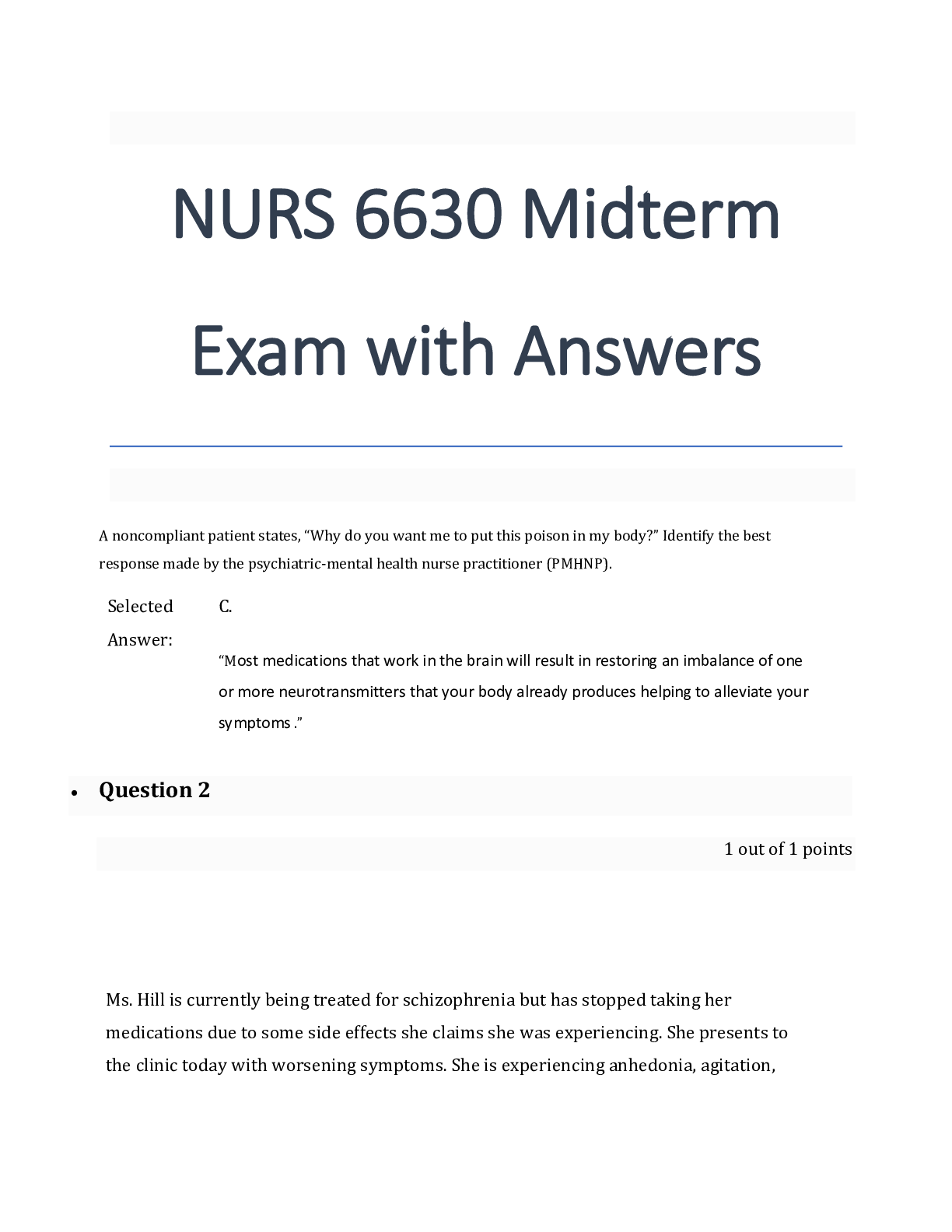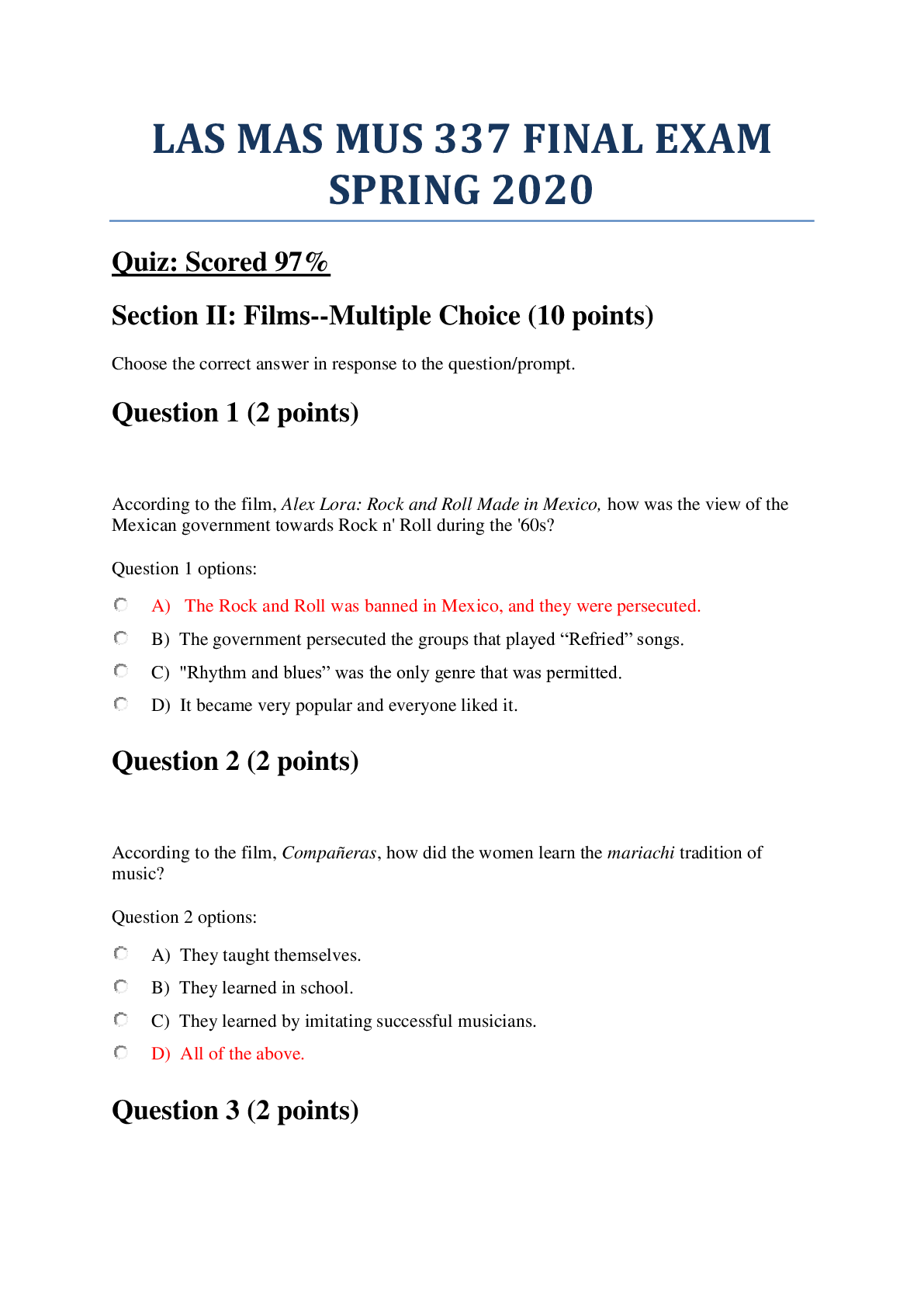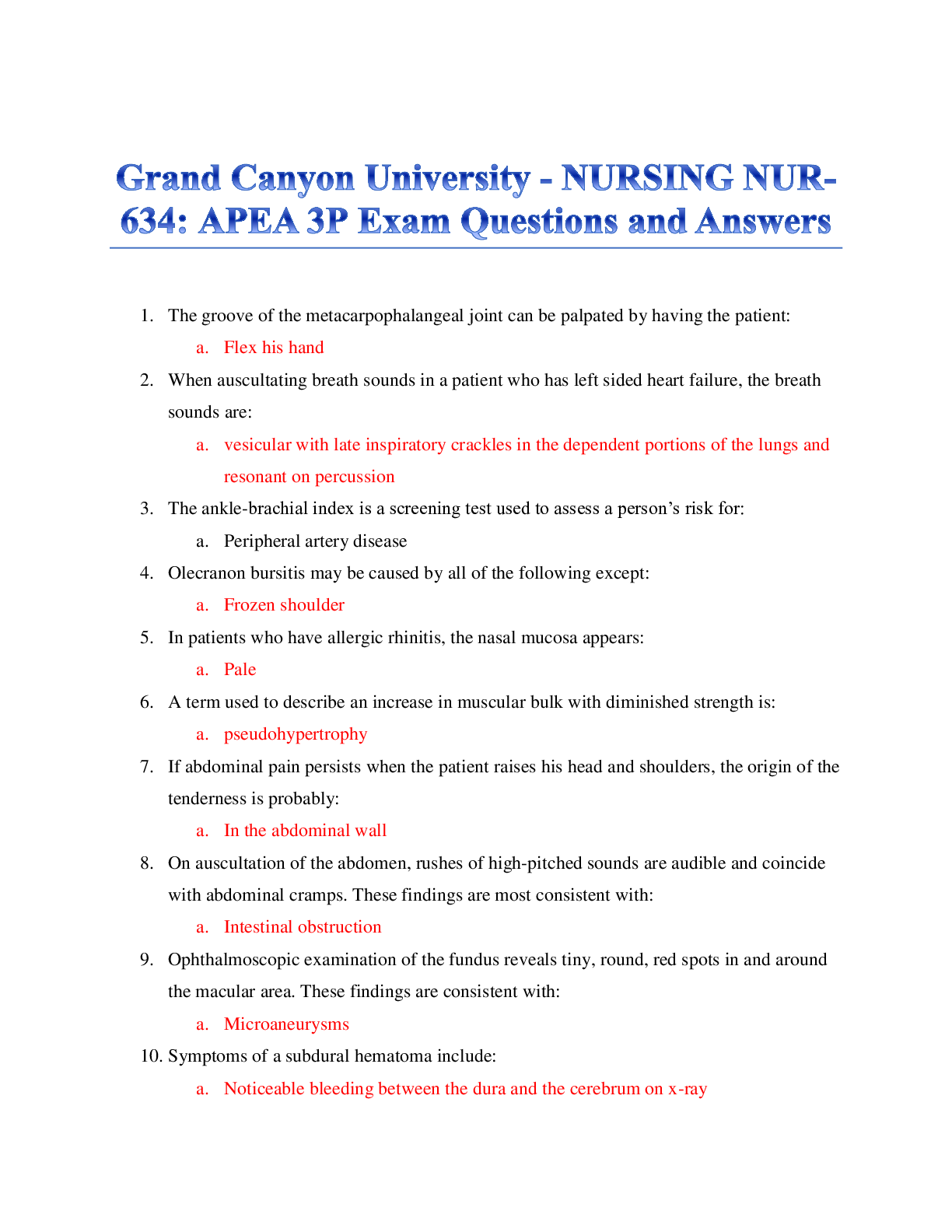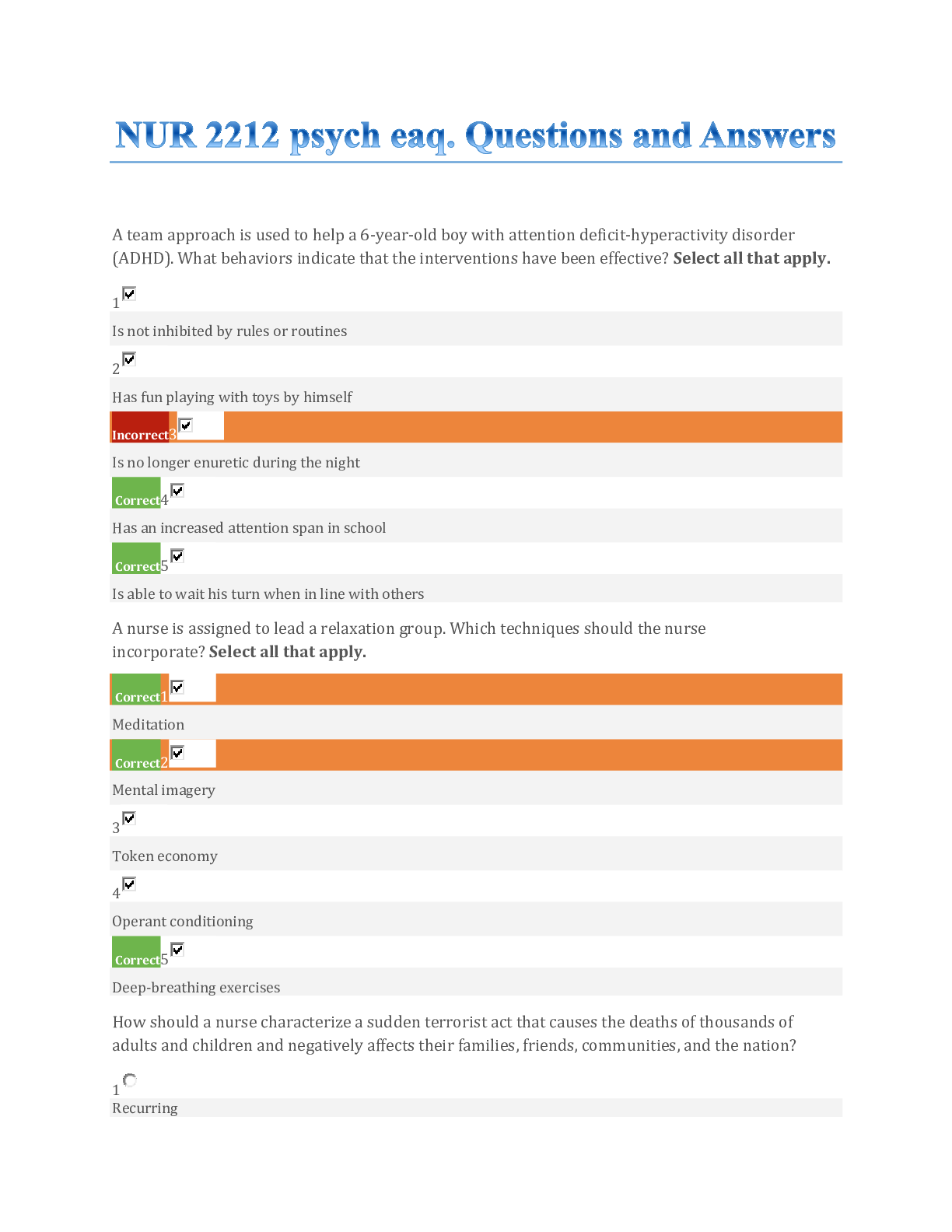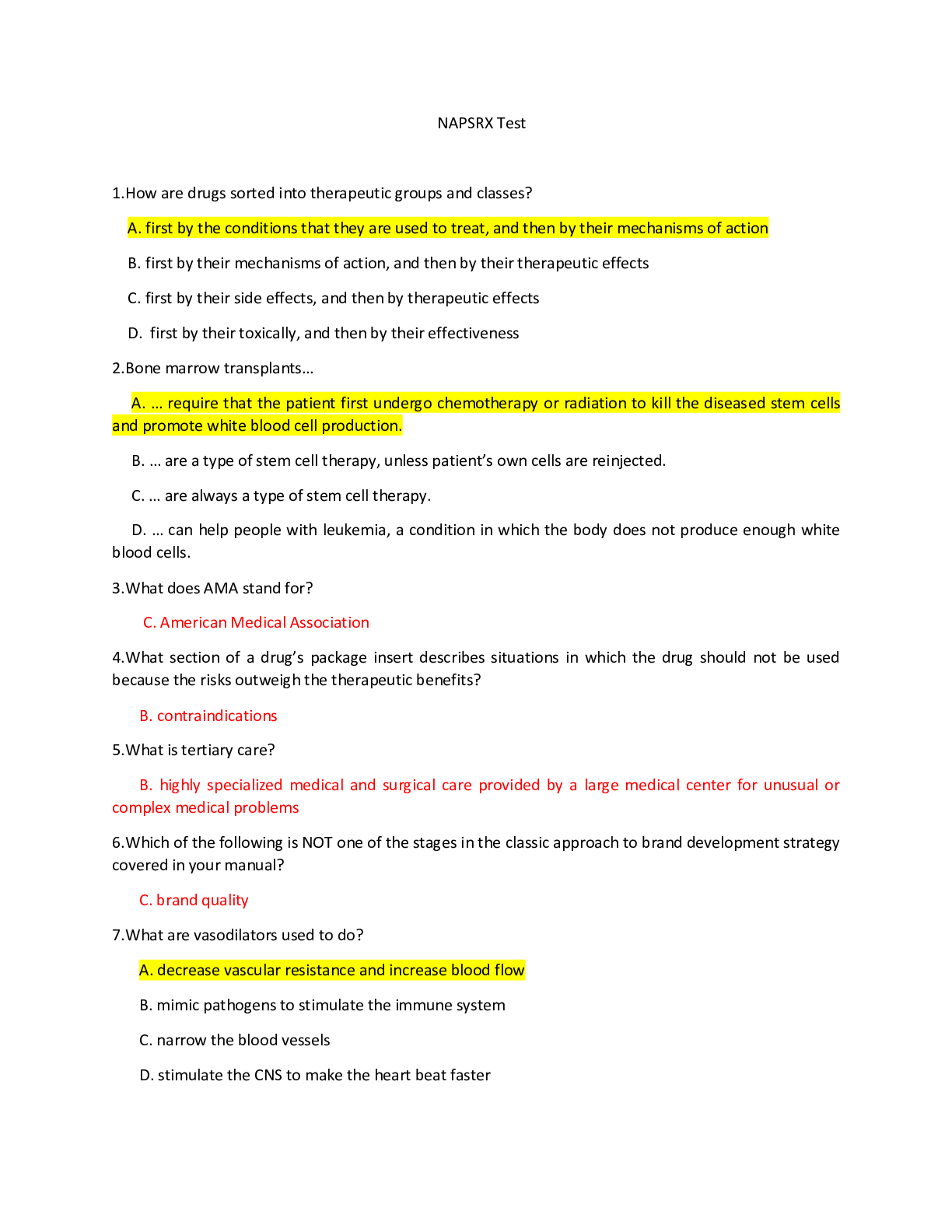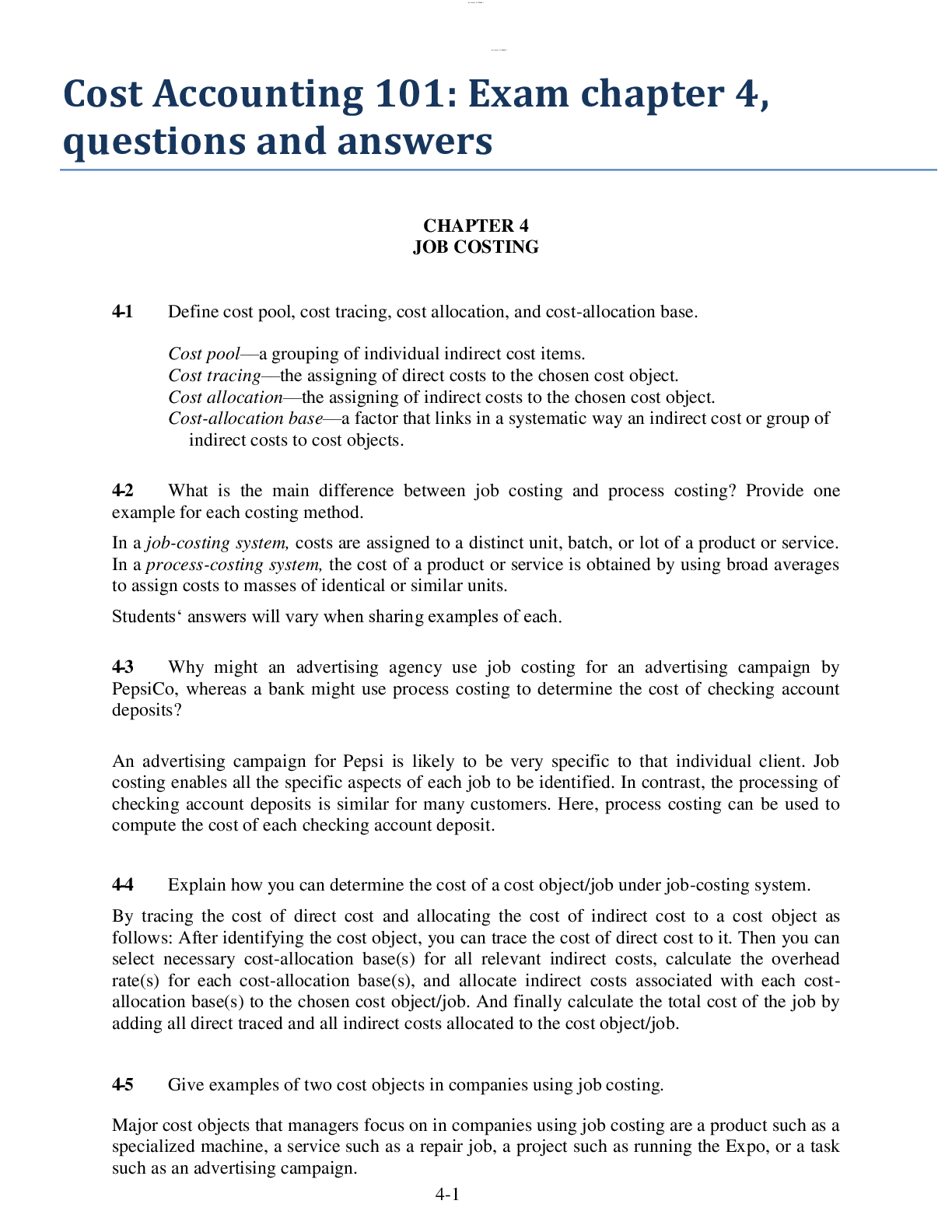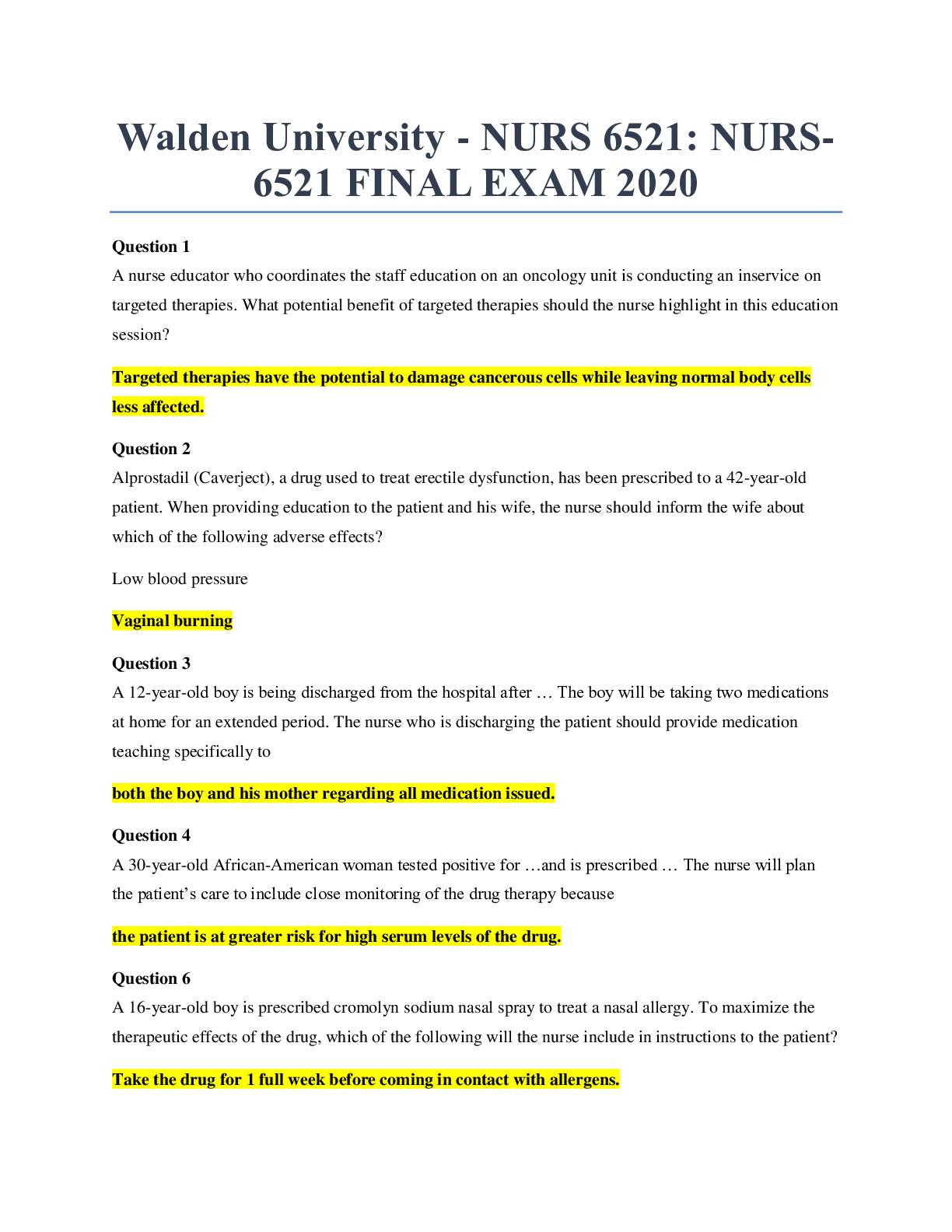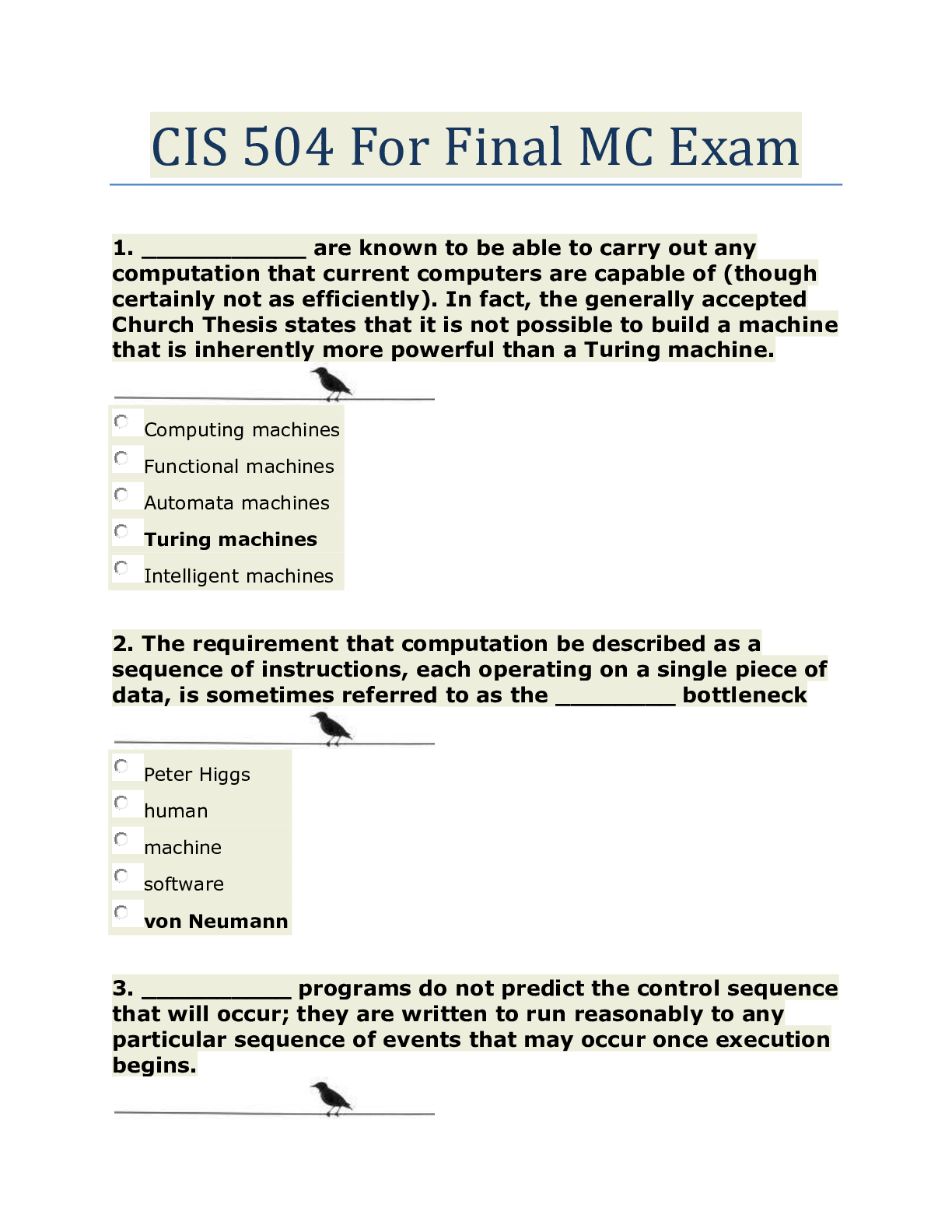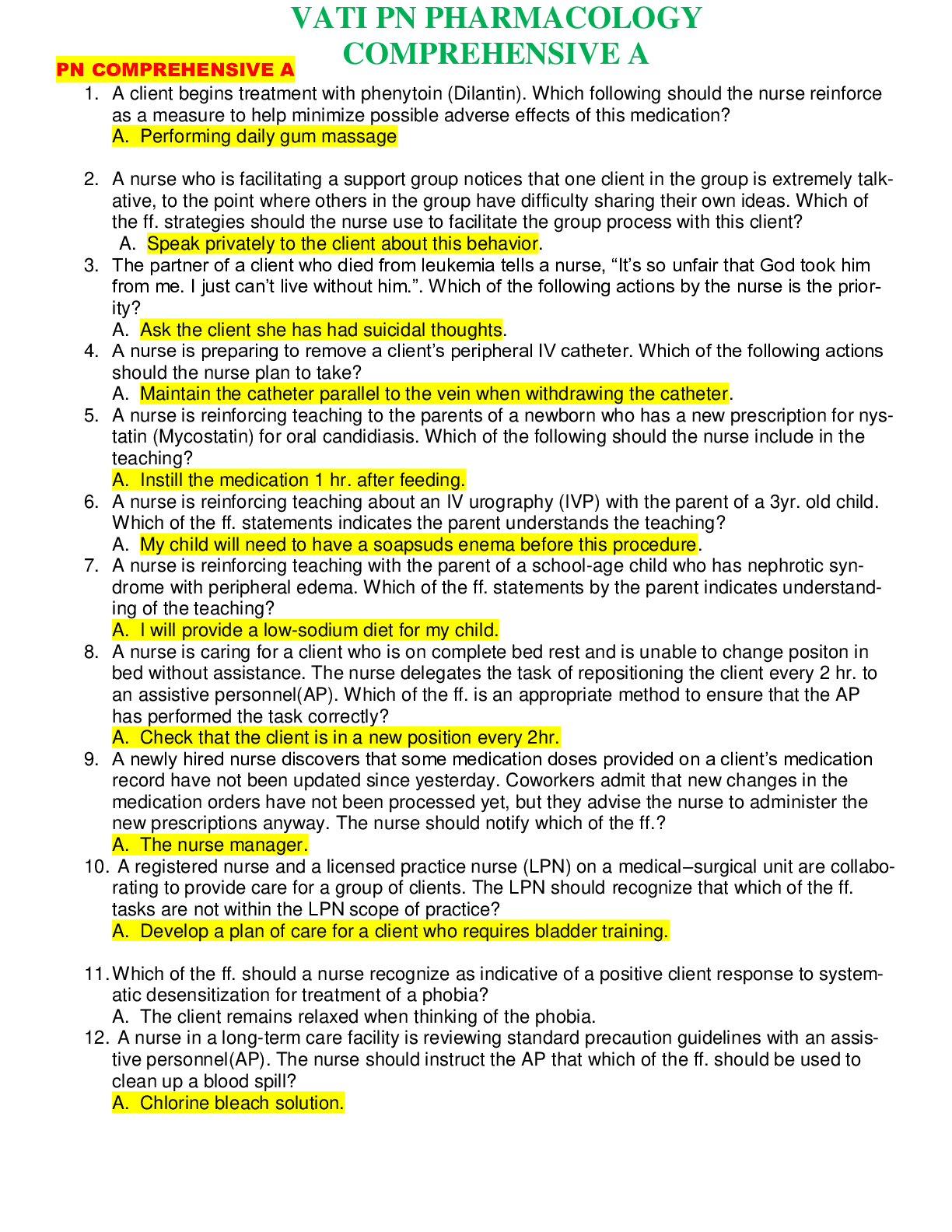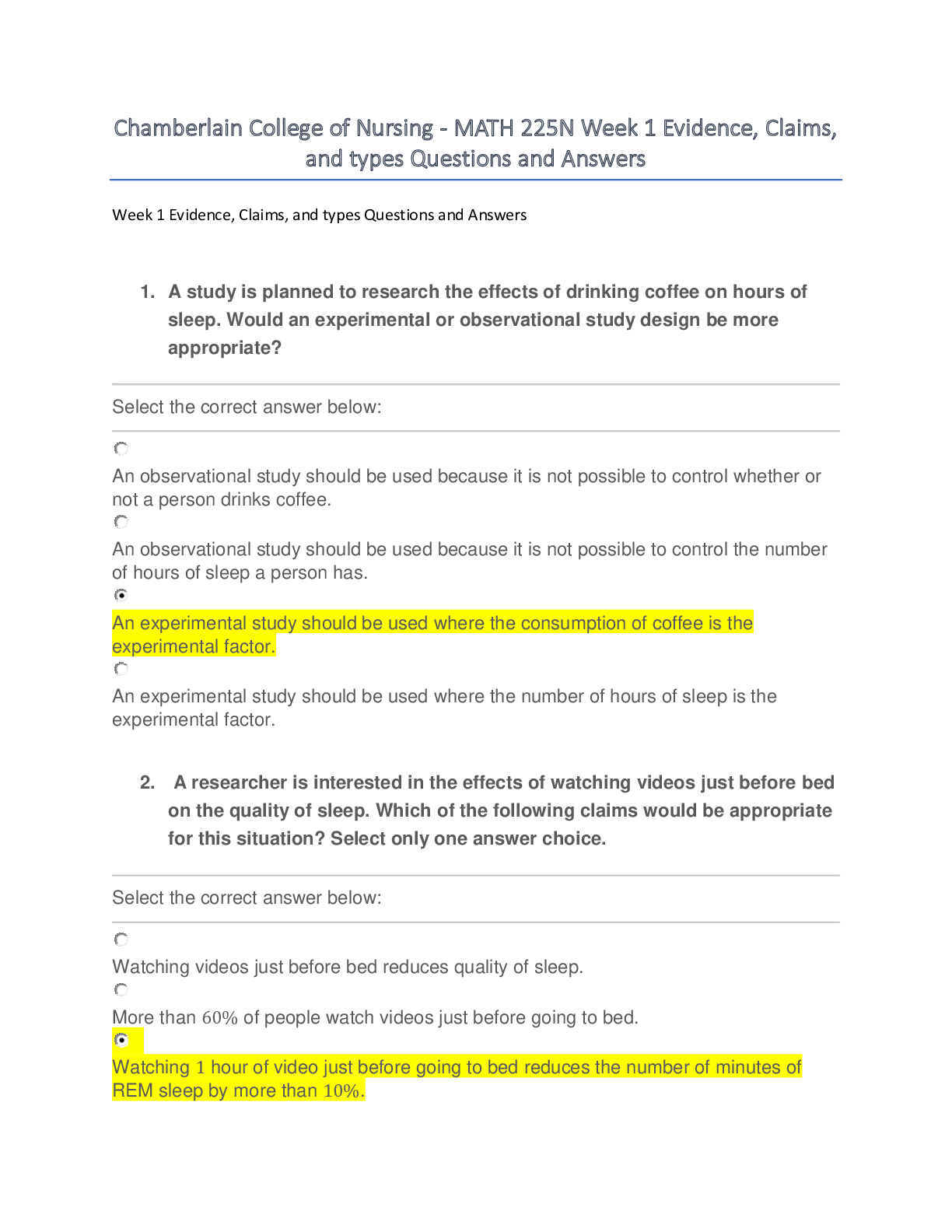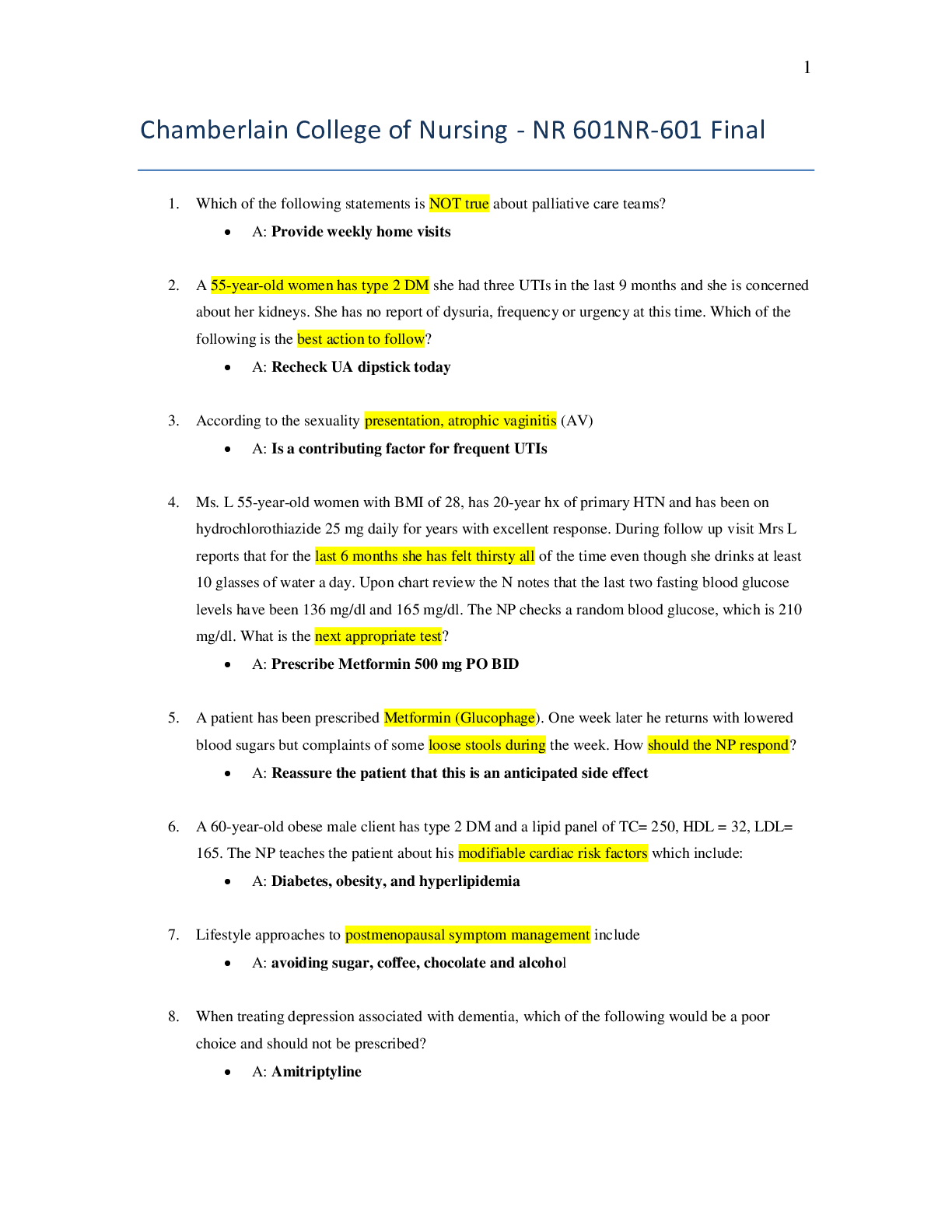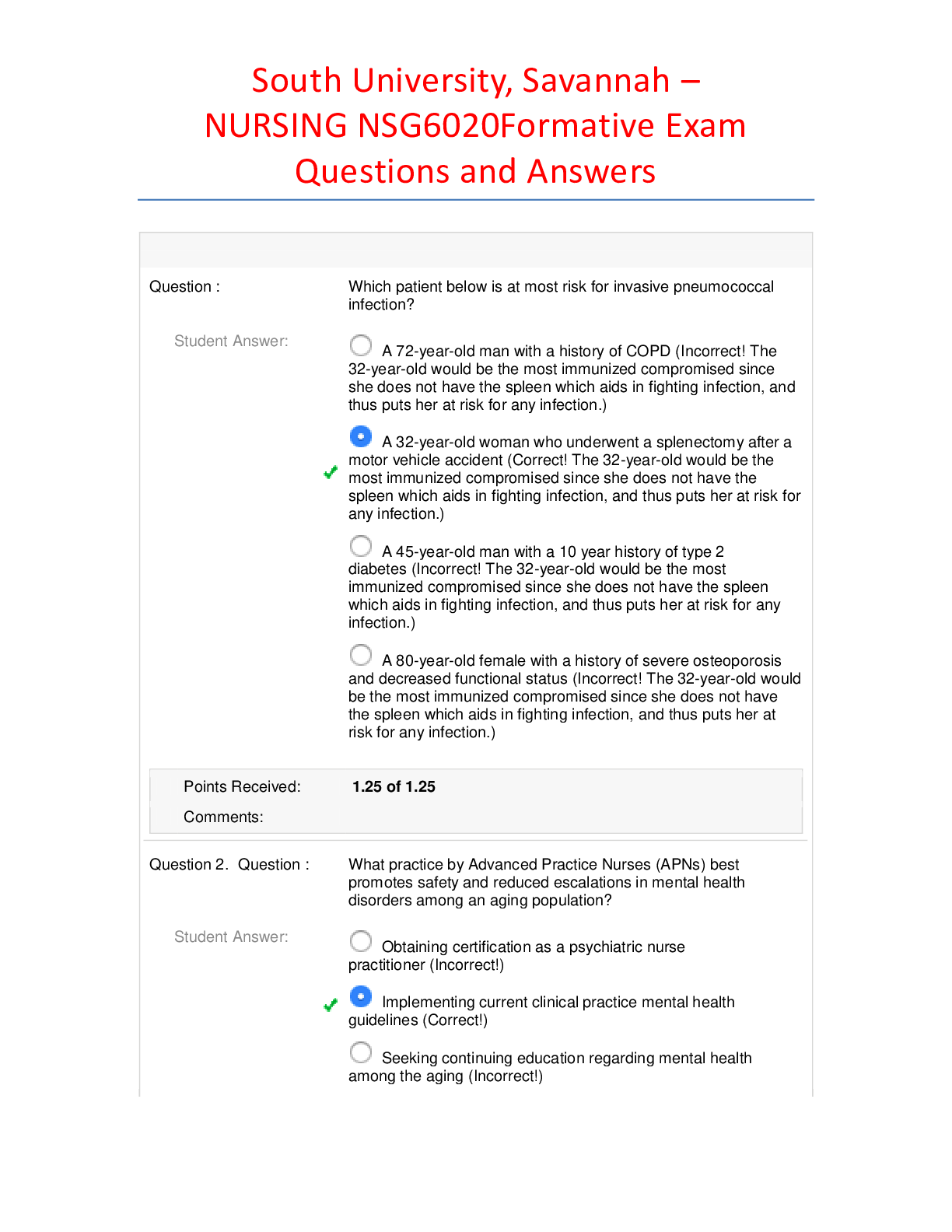History > EXAM > Quiz 7: Between Worlds: Late Antiquity and the Making of the Middle Ages, 476-900. Includes 50 Multi (All)
Quiz 7: Between Worlds: Late Antiquity and the Making of the Middle Ages, 476-900. Includes 50 Multiple Choice Questions, 15 true or False and 10 Essay Questions and Answers. 100% Exam-Correct Information.
Document Content and Description Below
Quiz 7: Between Worlds: Late Antiquity and the Making of the Middle Ages, 476-900 1. What events were held in the Hippodrome in Constantinople? A) religious ceremonies B) chariot races C) coronations... D) executions of Christians E) beast hunts 2. Which of the following was one of Justinian's many accomplishments? A) He enacted major religious reforms. B) He built walls that surrounded the capital. C) He updated the imperial law code. D) He oversaw a revival of classical studies. E) He enacted constitutional reforms that permitted peasants to vote. 3. How did the Corpus Iuris change women's rights over property? A) The Corpus Iuris ignored it. B) The Corpus Iuris denied it. C) The Corpus Iuris revised it. D) The Corpus Iuris restricted it. E) The Corpus Iuris erased it. 4. Under the Corpus Iuris, who controlled the foundation of the laws? A) the people B) military generals C) gods D) the emperor E) the consuls 5. The splendor of Hagia Sophia enhanced whose image? A) the clergy B) the city of Constantinople C) the architect D) the emperor E) Jesus of Nazareth 6. The splendor of Hagia Sophia enhanced whose image? A) the clergy B) the city of Constantinople C) the architect D) the emperor E) Jesus of Nazareth 7. What theological controversy did the Council of Nicea fail to solve, resulting in its continuation for several centuries? A) the debate about the nature of Christ, fully divine and fully human B) the sacraments in Communion C) the incorporation of the Hebrew scriptures into the Christian Bible D) the nature of God, whether eternal or time-bound E) the authority of bishops versus priests 8. What does "Christianity became imperial" mean? A) The pope became the emperor of the eastern kingdom. B) Justinian was head of the state and church. C) The emperor was linked to the church, while the image of Christ was transformed to ruler of the universe. D) The Byzantine church employed imperial troops to combat heretics. E) Justinian moved his court from the imperial palace to Hagia Sophia. 9. Which statement describes the lives of women in Byzantium? A) Women married young and needed to work the rest of their lives. B) Women enjoyed much elevated status because of the reforms implemented by Empress Theodora. C) Women tended to marry late or remain unmarried and enter convents. D) Women received about the same treatment as noble women. E) Women lived vastly different lives than women in ancient Athens. 10. Who did Belisarius, Justinian's general, defeat? A) Visigoths B) Vandals C) Vandals and other Goth tribes on the Italian peninsula D) Moslems E) Celts 11. In Constantinople, how many people died per day during the plague? A) 500 B) 1,500 C) 2,000 D) 1,000 E) 10,000 12. Who in Justinian's circle did NOT survive the plague? A) the queen B) his general C) his court D) his mother E) his son 13. What was notable about the revived Persian state? A) It had a democratic government. B) It had religious toleration. C) It followed pacifist policies. D) It adopted the Christian religion. E) There was a noticeable lack of display and formality around the emperor. 14. What empire recovered as Heraclius began his reign? A) Muslim B) Roman C) Frankish D) Gothic E) Persian 15. How did Heraclius maintain the Byzantine empire? A) He defeated the Mongolian army. B) He defeated three separate Persian armies. C) He reunited the Byzantine and Roman empires. D) He negotiated peace with Muslim forces. E) He divided his empire in half. 16. What were the two furthest regions that were connected by the Silk Road? A) Ctesiphon to Constantinople B) India to Turkey C) China to Constantinople D) China to Rome E) Alexandria to Ravenna 17. Why were inhabitants of Mecca hesitant to receive Muhammad's message? A) Muhammad was a newcomer, virtually unknown to the townspeople. B) He was practically penniless, with no discernible income. C) His message about Allah was clearly monotheistic. D) His reputation was sullied by reports of numerous affairs. E) He was not Arabic. 18. What does the world Islam mean? A) Allah is amazing. B) peace C) voluntary submission to God D) wisdom E) love and kindness to all 19. Where did Muhammad devise the main components of his new religion? A) Medina B) Mecca C) Baghdad D) Jerusalem E) Antioch 20. What do the essential beliefs of Islam say about it as a religion? A) It required intensive study of sacred texts to grasp its theology. B) It would require a hierarchy of administrators and teachers. C) It focused on mystical experiences and revelation. D) It expected followers to care for one another but did not expect extreme asceticism. E) It allowed wide latitude in the interpretation of key beliefs. 21. Which of the following best describes the penalties prescribed in Islam? A) They were revolutionary and unexpected. B) They were typical of the Near Eastern religions and law codes. C) They were exceptionally mild, even lax. D) They were handed down to Muhammad on stone tablets, just like the case with Moses. E) They were extremely harsh, even by ancient standards. 22. What office did Muhammad serve while he was in Medina and Mecca? A) the highest priest B) top military office C) true prophet D) religious and secular ruler E) foremost ambassador 23. How did Muhammad's followers view themselves? A) They saw themselves as outcasts, redeemed by Muhammad's sacrifice when he reclaimed Mecca. B) They saw themselves as members of the ummah, belonging to a united community of shared beliefs and practices. C) They saw themselves as ascetics, who must separate themselves from all worldly attractions. D) They saw themselves as prophets, for each Muslim should receive direct revelation from Allah. E) They saw themselves as priests, who could administer sacraments and perform religious rites. 24. What happened during Uthman's tenure as caliph? A) The Qur'an was written in full text form. B) Conquests were archived in Persia and Egypt. C) Muslims enjoyed a reign without any controversy or conflict. D) Muslims seized Spain from the Visigoths. E) The Hadith was recognized as an inspired text. 25. What office did Shiites insist must be direct descendants of Muhammad through Ali and Fatima? A) prophets B) kings C) satraps D) viceroys E) caliphs E 26. The Byzantines held Muslim incursions into the early eighth century with the help of what? A) Greek fire B) Viking mercenaries C) innovations in artillery D) expanded use of cavalry troops E) scorched-earth tactics 27. What did Byzantine emperor Leo the Isaurian decree? A) All Jews must convert or leave the empire. B) Women of all classes must refrain from using cosmetics. C) Polygyny was an acceptable practice. D) Religious images were akin to idols denounced in the Hebrew Bible. E) Religious authorities must be celibate. 28. Who gained control of the caliphate in the later seventh century and oversaw the creation of imperial Islam? A) Shiites B) Umayyads C) Bedouins D) Sasanians E) Sunnis 29. What happened during the Umayyad Caliphate? A) Muhammad was recognized as divine. B) Polygyny was officially accepted. C) Arabic became the official language of the government. D) Women could serve as Muslim priests. E) Women could serve in the Muslim military. 30. What was the difference between the Hebrew Scriptures or the Christian New Testament and the Qur'an? A) The Qur'an claimed to be inspired. B) The Qur'an distinguished between male and female genders. C) The Qur'an warned of an impending judgment. D) The Qur'an does not follow a narrative structure. E) The Qur'an described dietary restrictions. 31. Why is the Dome of the Rock sacred to Muslims? A) It housed the rock upon which Muhammad received revelation. B) It marked their greatest victory against the Byzantines. C) It was the first mosque to be built. D) It is believed to be the place where Muhammad ascended into heaven. E) It housed the meeting in which Shiites and Sunnis resolved their differences. 32. Which of the following is true about the caliphate in the early eighth century? A) The caliphate exceeded the power of the Roman emperors. B) The caliphate was in decline compared to its ascendant power in the seventh century. C) The caliphate was the most powerful governmental entity among similar institutions in the Mediterranean world. D) The caliphate was repressing the pursuit of knowledge and artist interests. E) The caliphate served as a model that western emperors used to reform their own governments. 33. Which of the following best describes the House of Wisdom, created by the caliph Haroun al-Rashid? A) It became the center of an Islamic revival. B) Byzantine troops ransacked it. C) It produced the first inscription of a verse from the Qur'an. D) It was a place for Christian, Jewish, and Muslim scholars to share ideas. E) It housed the first great library in the ancient world. 34. The Persian scholar Avicenna is especially noteworthy for his contributions to which field? A) astronomy B) agriculture C) mathematics D) medical knowledge E) Islamic theology 35. In order for Theodoric to seize authority over Italy, what did he have to do? A) He had to make peace with the caliph in Baghdad. B) He had to murder Odoacer, the Germanic leader with authority over the western Roman Empire. C) He had to remove all vestiges of Roman rule and offices. D) He had to convert to Catholic Christianity. E) He had to pay tribute to the Visigothic chief, Alaric. 36. What was Theodoric's religion? A) Zoroastrianism B) Catholic Christianity C) Islam D) Arian Christianity E) He remained a pagan. 37. Which of the following is a belief of Arian Christianity? A) Jesus came from a superior race of people. B) God the father created his son, and Jesus could not be divine. C) All members of the Trinity were coeternal and coequal. D) Catholicism had been corrupted during the last century. E) Muslims, as people of the book, should be tolerated. 38. Why were the Visigoths notable? A) They had great libraries and medical scholars. B) They practiced favorable treatment of religious dissenters, including Jews. C) They maintained rigid distinctions between Visigothic warriors and Roman families. D) They had a harsh law code that dictated severe penalties on Jews refusing to convert. E) They had a close relationship with Byzantine emperors. 39. What new German tribe moved into Italy after Theodoric's death in 526? A) Saxons B) Franks C) Lombards D) Visigoths E) Vandals 40. What did Boethius write in The Consolation of Philosophy? A) Biblical texts were far superior to classical writings. B) Reading Plato is more useful than reading Old Testament authors. C) He wrote about the vicissitudes of fate without mentioning the Christian God. D) He wrote a sarcastic diatribe, condemning all pagan authors. E) He described how the study of ancient philosophies garnered him international praise. 41. What did Cassiodorus say about the Christian life in his Institutes? A) It should be based on prayer and fasting. B) It should be spent in intense study of the Bible and other praiseworthy works of the church fathers. C) It was a life of sacrifice for others. D) It was a life spent in isolation from the temptations of the world. E) It should be dismissed or ignored, for the Christian God was not involved in the human world. 42. What rule did Benedict devise for western monastic orders? A) Monks should be organized in communal living. B) Monks should be required to work alongside peasants. C) All monks must devote themselves entirely to the study of the Bible. D) All monks should ignore the Roman pope. E) All monks should be trained to combat Islam. 43. What were double monasteries? A) They were monasteries that housed priests and monks. B) They were always led by men. C) They were monasteries created as pairs. D) They housed both monks and nuns. E) They were short-lived because expenses were doubly costly. 44. What were double monasteries? A) They were monasteries that housed priests and monks. B) They were always led by men. C) They were monasteries created as pairs. D) They housed both monks and nuns. E) They were short-lived because expenses were doubly costly. 45. Irish monks wrote some of the first A) musical pieces for monks. B) commentaries on the Gospels. C) laws used by Germanic tribes. D) preaching handbooks, full of saintly anecdotes. E) penitentials, treaties that described what behaviors were deemed sinful. 46. Who was responsible for establishing the Merovingian dynasty? A) Alaric B) Odoacer C) Clovis D) Alfred E) Bede 47. What position, usually ruling their districts independently, helped early medieval Frankish kings? A) comes or counts B) knights C) satraps D) abbots E) bishops 48. Charlemagne's introduction of a new denarius coin allowed for what? A) It precipitated the decline of Muslim authority in Europe. B) It allowed for the growth of trade. C) It signified his power over papal mining of silver. D) It advertised the invention of new mining techniques. E) It announced the switch from gold to silver currency. 49. What improved Frankish agriculture in the eighth and ninth centuries? A) the moldboard plow B) wind-driven water mills C) new fertilizers D) the transition from horses to oxen E) the change in climate 50. What is remarkable about the German noblewoman Hroswitha? A) She engineered a palace coup that toppled Charlemagne's rule. B) She became the leading theologian in her day. C) She was notable for her work in medicine. D) She was exceptionally literate and wrote several comedies with strong female characters. E) She ruled as the only female pope. 51. The Corpus Iuris had a limited impact and was only used in the Byzantine Empire. 52. Justinian's queen, Theodora, had little sway in his reign; she was primarily important for ceremonial purposes. 53. Justinian was solely interested in Constantinople, and he made no significant improvements in any other cities within the Byzantine Empire. 54. Although Heraclius won impressive victories against the Persians, he was responsible for losing Jerusalem to the Muslims. 55. The Qur'an required Muslims to radically change how they would have previously dealt with personal insults. 56. Unlike the Jews or early Christians, Muslims could not own slaves. 57. Islam is similar to Judaism because both maintain the need for a central religious leader and teacher. 58. The Umayyad caliphate allowed Christians and Jews to congregate, and Christian churches were built within its borders in the first decades of this government. 59. Islamic scholarship accepted all Greek learning wholesale. 60. Christian monks had formed communal associations, where they lived in common together, since the dawn of Christianity. 61. In late antiquity, landowners in western Europe were forced to identify as a "Roman" or as a "Frank." 62. In 732, Charles Martel repulsed a raiding party of Spanish Muslims at the Battle of Tours, and the Spanish stopped venturing into France. 63. The missi dominici were Charlemagne's henchmen, trained as assassins. 64. While Frankish husbands had exceptional authority over their wives, they could not have a wife executed. 65. The Carolingian Renaissance was widely successful; numerous schools were built and literacy improved among all classes of people. 66. How did Justinian increase the power of the Byzantine emperor? 67. What challenges did the Byzantine Empire encounter after Justinian's reign? 68. What challenges did the Byzantine Empire encounter after Justinian's reign? 69. How did the Islamic world evolve after the death of its founder, Muhammad, in 632 CE? 70. How did the Islamic world evolve after the death of its founder, Muhammad, in 632 CE? 71. Compare and contrast the tenets of Roman/Byzantine and Germanic law. 72. Explain how Pope Gregory I laid the foundations for the medieval Catholic papacy. 73. Discuss the contributions of noble and peasant women to Frankish society. 74. Compare and contrast the civilizations formed by the Merovingian and Carolingian Franks with that of the Umayyad caliphate. 75. Did Charlemagne's territorial accomplishments deserve the designation of "empire"? [Show More]
Last updated: 2 years ago
Preview 1 out of 17 pages

Buy this document to get the full access instantly
Instant Download Access after purchase
Buy NowInstant download
We Accept:

Reviews( 0 )
$13.00
Can't find what you want? Try our AI powered Search
Document information
Connected school, study & course
About the document
Uploaded On
Nov 24, 2020
Number of pages
17
Written in
Additional information
This document has been written for:
Uploaded
Nov 24, 2020
Downloads
0
Views
108

